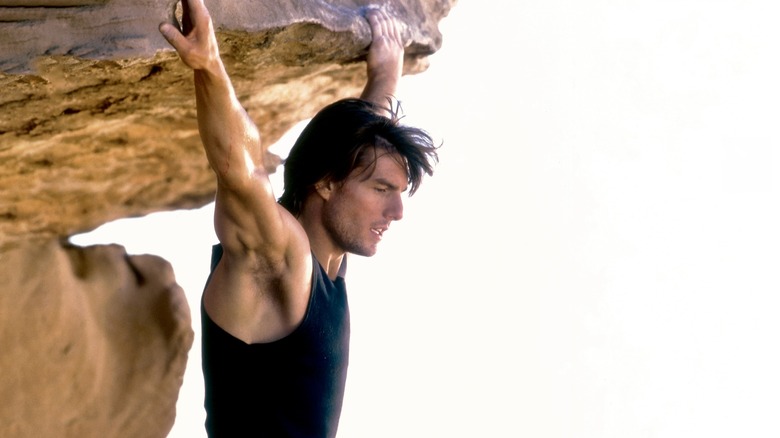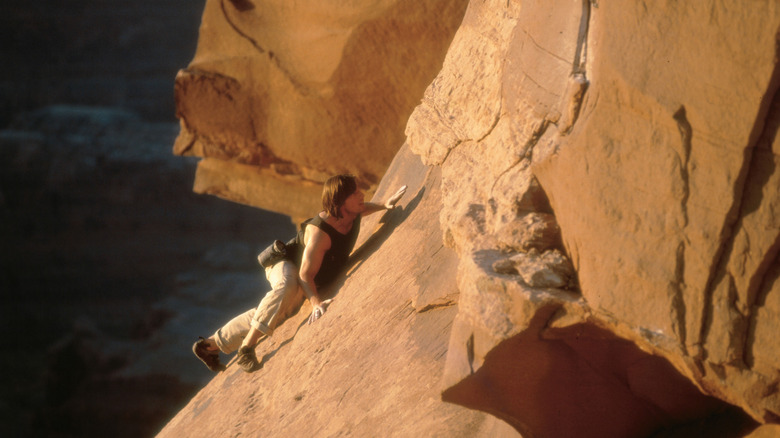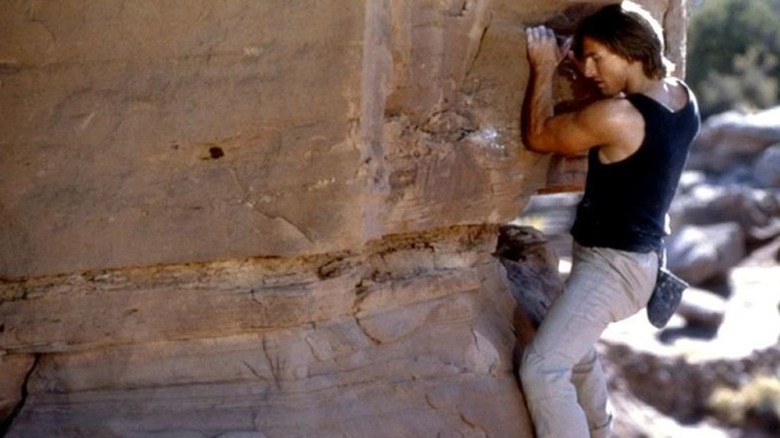Tom Cruise Terrified John Woo With The Opening Stunt Of Mission: Impossible 2
Brian De Palma's 1996 spy thriller "Mission: Impossible" was considered revolutionary at the time, bringing a level of slickness and first-rate production value to the spy genre never before seen outside of James Bond. John Woo's 2000 follow-up "Mission: Impossible 2" abandoned the first film's terseness and efficiency right away, making a noisy, overblown, stylish stunt spectacular. Physics was abandoned for Woo's film, and plot clarity took a back seat to nonsensical sexy action shenanigans. The 2000-era pop music soundtrack was dated about eight days after the film's release. Weirdly, it was the sequel's grandiose qualities that would come to dictate the tone and ambition of the further "Impossible" sequels.
Case in point: "Mission: Impossible 2" was the first film in the series to introduce Ethan Hunt (Tom Cruise) in the middle of a life-threatening stunt. After the events of the first film, Ethan has decided to take a vacation, presumably away from the watchful eyes of his bosses at the IMF. Ethan spends his spare time, it seems, mountain climbing in Dead Horse Point in Utah, defying death by not wearing ropes or a harness. Cruise's climbing double for the climbing sequences was a professional named Ron Kauk, but he only appeared in certain wide shots where Cruise's face couldn't be seen. The dangerous fingertip dangling wherein Cruise's face and body could be seen was actually Cruise. Yes, it seems the actor is also adept at mountain climbing.
In a 2000 issue of EW, director Woo revealed just how anxious he was while filming Cruise in legitimate danger. His anxiety, of course, is completely understandable. For one, one of the most bankable stars in the world was putting himself in mortal danger. For another, Woo would have to get up in the mountains to shoot the dang scene.
Use real cliffs!
Woo, as a director, could instantly think of safer ways to get similar shots, immediately thinking that Cruise could climb a constructed rock face that wasn't so far from the ground. Cruise, however, served as a producer on the film and insisted on climbing on real cliff faces. Cruise, of course, was going to be outfitted with a safety harness and a very thin cable, and he was to be consulted by Kauk and a few other professional climbers. These precautions, however, weren't enough to set Woo's mind at ease. The director said:
"I was really mad that he wanted to do it, but I tried to stop him and I couldn't. [...] I was so scared I was sweating. I couldn't even watch the monitor when we shot it."
Woo was doubly disappointed — and terrified — when he didn't get some of the film's more harrowing shots in one take. Cruise was eager to work as hard as possible, so he certainly didn't mind doing multiple takes of each dangling scene. Woo was merely frustrated that, despite a retinue of camera operators, couldn't get every shot framed up and focused correctly. He said:
"We had five cameras on the cliff, including a helicopter camera, a camera on a crane, and cameramen hanging from safety cables, but we had focus problems, so we had to do it again and again. But Tom would say, 'I'm okay, John, don't worry, I want to do it one more time."'
Cruise, meanwhile, had a blast. In 2000, UK Climbing Magazine interviewed Earl Wiggins, one of the above-mentioned camera operators, and he went into detail about how the climbing shots were achieved, and the surprising amount of scrambling Cruise did himself.
The climbing itself
Wiggins revealed just how dangerous everything was. It seems that the cliff in question — the one that Cruise was actually on — was about 600 feet up from the nearest standing surface and about 2,000 feet to the river below. Wiggins pointed out that Cruise and Kauk became good friends while working together, and it was Kauk that gave Cruise the confidence and the wherewithal to tackle the rock face, saying:
"During filming, Ron would escort Tom into position and then get clear for each shot. We used winches to get Tom in and out of position. The rigging entailed cantilevered trusses on the rim to direct ropes. Tom did all of the climbing except the slip off the overhang — his main stunt double, Keith Campbell, did that stunt. Tom was on the cliff parts of five days for the filming and never complained which is rare for a big star."
Woo may have been nervous about shooting, but, according to Wiggins, still wanted it to look like a John Woo movie. For instance, Woo liked to position his many action stars n dramatic poses as often as possible. It seems Woo insisted on the famous shot of Cruise clinging to a rock with his arms extended on either side of him, facing outward toward the ravine.
"The climbing was choreographed by the film's stunt coordinator, Brian Smrz, who is arguably the best in the business. However, the choreography was inclusive of several elements that John Woo had felt were essential. The crucifix position is, I am told, in every John Woo film. I can't say if that is actually true but it was important to John."
Wiggins assured readers: no real-life climbing routes were damaged during production.


